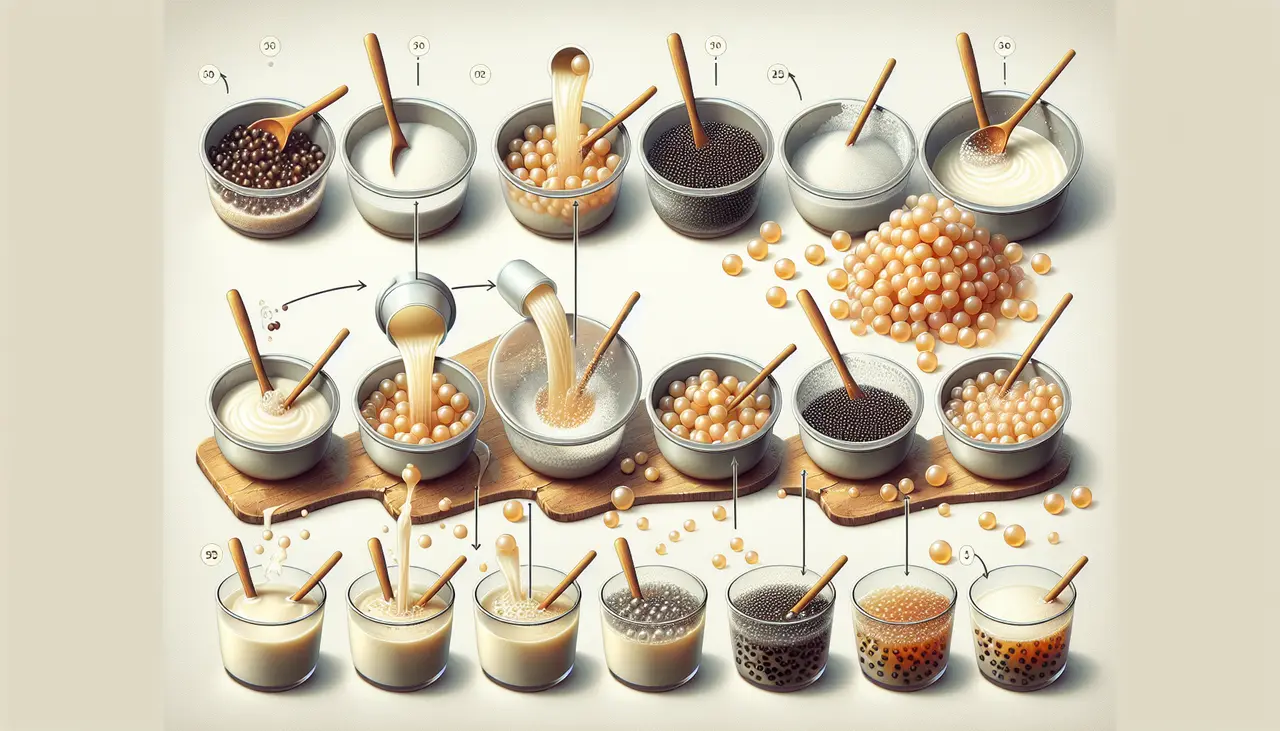Introduction to Chewy Bubble Tea: What Makes It Special?
Bubble Tea, also known as Boba Tea, has taken the world by storm, largely thanks to its signature chewy tapioca pearls. But ever wonder what magic formula makes these pearls so irresistibly chewy? It’s all about the science behind it. Tapioca pearls are made from the starch of the cassava root. When mixed with water and heated, the starch turns into a sticky, gummy texture – think of it as the glue that holds the pearls together. The pearls are then shaped and cooked until they reach that perfect balance of chewiness and bounce. But here’s the secret sauce: the cooking time and temperature are crucial. Too little, and the pearls are too hard; too much, and they turn into mush. It’s this precise science that makes your bubble tea experience either a delight or a letdown. So next time you’re sipping on that chewy boba, remember, it’s not just a treat; it’s a masterpiece of culinary science.
The Origin and Popularity of Chewy Bubble Tea
Bubble tea, also known as boba tea, has a history that dates back to the 1980s in Taiwan. It started when tea shop owners began adding fruit, syrup, and tapioca pearls to their drinks, creating a new sensation. The tapioca pearls, or ‘boba,’ are what give bubble tea its distinctive chewiness. This drink quickly gained popularity in Taiwan and then spread across Asia. In the late 1990s and early 2000s, bubble tea started to make its way to North America and Europe, appealing to a wide audience with its unique textures and customizable flavors. Today, bubble tea is a global phenomenon, celebrated for its delightful combination of sweet tea and chewy tapioca pearls. People love being able to customize their drinks with different types of tea, levels of sweetness, and various toppings. The rise of social media has also contributed to its popularity, with colorful photos of bubble tea cups becoming a common sight on Instagram and other platforms. The chewiness of the boba, combined with the refreshing tea and the visual appeal of the drink, are key to bubble tea’s enduring popularity.
The Science of Texture: What Makes Boba Chewy?
The secret behind that perfect chewiness in your boba lies in the science of texture. At its core, boba pearls are made from tapioca starch, which is derived from the cassava root. When this starch mixes with water and heat, it undergoes a transformation. The science bit? It’s all about the gelatinization of the starch. This process, where heat and moisture turn the tapioca starch into a gel, is key to achieving that signature chewy texture.
To nail the perfect chewiness, timing and temperature are crucial. The pearls need to be cooked just right – too little, and they’re hard in the middle; too much, and they turn to mush. After cooking, a quick bath in cold water stops the cooking process, maintaining that ideal chewiness. But it’s not just about cooking; the added sugars play their part too. They seep into the pearls, tweaking the texture further and adding that hint of sweetness that makes boba irresistible.
In a nutshell, making boba chewy is no small feat. It’s a careful blend of science and art, where understanding the role of tapioca starch and mastering the perfect cooking conditions come together to create the boba we all love. Whether in a milk tea or a fruit-infused drink, that chewy texture is what turns a simple sip into a delightful experience.
Key Ingredients for the Perfect Chewy Boba
The secret to that perfect chew in boba comes down to a few crucial ingredients. First up, tapioca starch. It’s the star of the show, giving boba its signature chewiness. No tapioca starch, no chew. It’s that simple. Then, there’s water. Sounds basic, right? But it’s all about getting the ratio to starch just right. Too much, and your boba goes mushy. Not enough, and it turns into little rocks. Next, we throw in some sugar. This isn’t just to sweeten the deal; it also helps with the texture, giving those little balls a slight gloss and a better chew. Some recipes even add a touch of caramel color to get that perfect golden-brown look. Remember, making chewy boba is more art than science. These ingredients need to be mixed, kneaded, and shaped with care. Get it right, and you’ve got yourself boba worth bragging about.
Starch in Boba: The Secret to Chewiness
Starch is the game changer when it comes to the chewiness of boba. Found mainly in the tapioca pearls that boba is made of, starch has the power to absorb water and swell up. This process, known as gelatinization, turns the hard pearls into the soft and chewy balls everyone loves in their tea. There are different types of starch, but the one in tapioca pearls comes primarily from the cassava plant. As it heats up during cooking, the starch granules start to absorb water, swell, and eventually burst. This bursting turns the mixture into a thick, jelly-like texture. Then, as it cools down, it becomes even chewier. Remember, not all starch behaves the same way, so the unique starch in tapioca pearls is what gives boba its signature chewiness. Plus, the skill of the boba maker in managing the cooking time and temperature can make or break the texture. So, when you enjoy that perfect chewiness, you’re actually experiencing a bit of science magic thanks to starch.
The Cooking Process: Achieving the Perfect Chew
The journey to perfectly chewy boba starts with the cooking process, often seen as a true test of patience and precision. First, raw tapioca pearls are soaked in water. This step is crucial for making them soft enough to cook evenly. Once soaked, the pearls are boiled in hot water for about 20 minutes. Here’s where attention to detail matters. Boiling for too long will make them mushy, but not enough time in the water, and you’ll end up with a hard center.
After boiling, the pearls undergo a quick ice bath. This sudden temperature drop stops the cooking process instantly, helping to lock in that sought-after chewiness. Next, they’re slowly simmered in a sweet syrup, usually a mix of sugar and water, sometimes with added flavors like vanilla or honey. This simmering process not only adds flavor but also gives the boba a glossy shine and an even chewier texture.
So, boiling and simmering are the keys to achieving the perfect chew in your boba. It’s a delicate balance, requiring a watchful eye and a steady hand. Get it right, and you’re rewarded with boba that’s soft, chewy, and irresistibly satisfying in every sip.
Temperature and Time: Critical Factors in Boba Preparation
Getting perfectly chewy boba balls depends a lot on temperature and time. Think of these two as the secret ingredients that are not so secret. First off, the mixture used to make boba – typically tapioca starch and water – needs to be cooked at just the right temperature. Too hot, and you’ll end up with a mushy mess. Not hot enough, and the pearls won’t cook through, leaving you with an unpleasantly hard center.
The ideal temperature range for cooking boba pearls hovers around 194°F to 212°F (90°C to 100°C). This range is crucial for activating the starches in the tapioca, turning them into the chewy delights we all love. But it’s not just about hitting the right temperature; how long you keep the pearls at this temperature matters too.
Cooking time can vary, but it generally falls between 20 to 30 minutes for the initial boil. Post boiling, a critical step follows – the rest period. This is when the boba pearls are left to sit in the hot water, and it’s a game-changer. Letting them rest for about another 20 to 30 minutes allows the heat to distribute evenly, ensuring the inside of the pearls cook to that perfect chewy consistency without getting too soft on the outside.
So, there you have it. Temperature and time are the behind-the-scenes heroes in the quest for perfectly chewy boba. Too much or too little of either, and you won’t hit the sweet spot. Keep these factors in check, and you’re well on your way to boba greatness.
Sweetness and Flavor: Enhancing the Chewy Experience
To make boba perfectly chewy and delicious, the sweetness and flavor play huge roles. Think of boba as tiny flavor-packed sponges in your drink. The process starts with the boba pearls being cooked in a mixture of sugar and water. This is where the magic happens. As they cook, they soak up the sweetness, which gives them their signature taste. But it’s not just about making them sweet. The flavor is key. After cooking, boba pearls are often soaked in a syrup. This syrup can be anything from simple sugar syrup to more complex flavors like honey, caramel, or fruit syrups. The longer they soak, the more flavor they absorb. Imagine drinking a tea and suddenly getting a burst of caramel or strawberry in your mouth. That’s the power of well-flavored boba. It’s all about balance. Too little flavor, and the boba might taste bland against the drink. Too much, and it can overpower the tea. The goal is to enhance your chewy experience, making each sip a perfect blend of tea and boba. So next time you sip on your favorite boba drink, remember, it’s the sweetness and flavor that make those little pearls so irresistibly good.
Troubleshooting Common Boba Texture Problems
When making boba at home, hitting that perfectly chewy texture can be tricky. If your boba is too hard or too mushy, don’t worry. Here are some quick fixes. If your boba comes out too hard, it’s likely not cooked long enough. Boil them a bit longer, checking every few minutes until they reach the desired chewiness. Remember to use plenty of water to keep them from sticking together. On the flip side, if your boba is too soft and mushy, it’s probably overcooked. Next time, cut the cooking time a bit and do a taste test sooner. Another common issue is boba getting hard after sitting out. To prevent this, after boiling and draining, soak your boba in a sugar syrup or honey. This not only adds flavor but helps keep them soft. Lastly, always use your boba right away. They’re best enjoyed fresh and don’t store well, even if you refrigerate them. So, boil what you need and enjoy immediately for that perfect chew.
Conclusion: Mastering the Art of Chewy Bubble Tea
Mastering the art of chewy boba isn’t just a craft; it’s a science. Perfectly chewy bubble tea pearls don’t happen by accident. It’s all about the right blend of tapioca starch, water, and sometimes a bit of sugar and flavoring. The magic lies in the proportions and the cooking process. Start with boiling water, then add the boba pearls, making sure to stir gently to prevent sticking. Timing is crucial – not enough boiling, and your pearls will be hard; boil them too long, and they turn mushy. It’s all about finding that sweet spot where they’re perfectly chewy. After boiling, a quick plunge into cold water stops the cooking process and adds to the chewiness. Quality ingredients, precise timing, and a bit of patience are your best friends in achieving that sought-after boba texture. So next time you sip on that bubble tea, remember the science and craft that went into making those perfect chewy pearls.








Leave A Comment